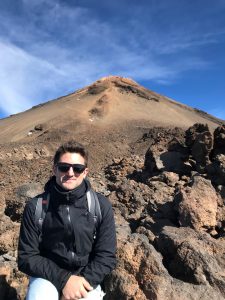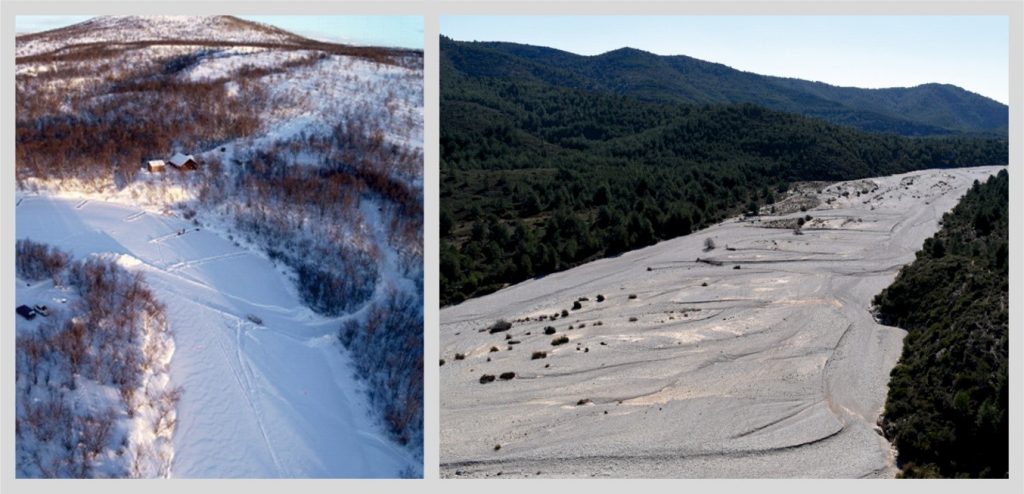
Mikel Calle Navarro, PhD
TSCMT Post-doctoral researcher at the Department of Geography
Before you keep reading, please think for a moment the scenery the word ‘river’ evokes to you… Does it include a flowing water line with green trees on sides, swimming fish or some other animal drinking water from it? Did your picture resemble the one in Collins’ dictionary? “A river is a large amount of fresh water flowing continuously in a long line across the land”.
Here you have two pictures (Figure 1), on the left a river covered by a thick ice and snow layers, on the right a river completely dry. Does your mental scenery for ‘a river’ -or the Collin’s- fit with some of these pictures? So, the question is, what do they have in common?

Figure 1: Pulmanki River, Finnish Lapland (left, photo by FCRG) and Rambla de la Viuda River, Valencia, Spain (right, photo by FloodsRG)
Ok. Let’s start.
Rivers are spread all over the world. They bring many services to the present society: drinkable water, food (and jobs-related), a recreational space for both sailing or swimming, an aesthetic landscape to put on Instagram, and many others. They also provide a source of energy (e.g. hydro-power), irrigation for our croplands, industry and farms. In a few words, we rely on rivers all over the world to bring such a precious treasure: WATER. In the same way, nature rely on rivers to bring all the nutrients and water that it needs to develop. But also -and more important- rivers bring an ample range of habitats that support life and biodiversity, both inside and outside the river itself.
Humans, in order to cover our increasing demands as a growing society, we have taken advantage of the many resources river bring us. Not without a great cost. Rivers became one of the most fragmented and altered freshwater ecosystems globally [1]. Human induced pressures, in addition to climate warming, are causing severe and continuous degradation of rivers. And we do not know how to stop it yet.
Intensive research dealing with effective ways of mitigation or managing these impacts have been of especial focus in Europe since the year 2000, after the enforcement of the European Water Framework Directive – WFD [2]. This Directive is an ambitious project that aims to reach a good environmental state of rivers across Europe. It enacts exhaustive monitoring measures to ensure homogeneous environmental standards mostly regarding water quality, invasive species, or environmental flow (minimum river flow to support life).
It was a nice try.
However, after 20 years of implementation, European surface water bodies showed “limited change in status”, according to the European Environmental Agency [3]. In his periodical report, the Agency pointed out that the most significant pressure is related to hydromorphological impacts (38%), followed by water pollution by diffuse sources (35%), by point sources (17%) and water abstraction (7%). From a scientific point of view, hydromorphology refers to the “genuine combination of change, form/substrate and the flow regime with relevance at the habitat scale” [4]. In other words, it refers to the shape of the river (e.g. meandering or straight, narrow or wide, deep or shallow), the processes that rework sediments to create that river shape (e.g. episodic flooding or continuous meander shift), and its change through time (river dynamics).
Summing up, after implementing the European WF Directive during 20 years limited change has been observed. The main pressure on rivers: hydromorphology, i.e. the physical environment.
It is time now to focus again into the question on top of this article: What scenery does the word ‘river’ evokes to your mind? When you thought about it, did you add any sediment to the imaginary picture of yours? Maybe you did! In such a case, you found the singularity of rivers: THE SEDIMENT! This is what the two pictures had in common, and also every single river on Earth. Being precise, it is the movement of sediment along the rivers and the morphology that generates when interacts with water flowing what they share. Digging a bit deeper in literature, we realize that sediment fluxes and dynamics play a critical role in river morphology and therefore in river ecosystem functioning, biodiversity and its healthy dynamics [5, 6, 7, among many others]. If we follow these statements, we should consider the physical environment of rivers (hydromorphology) -and in particular sediment flows- as the foundation for an adequate biological and ecological development of river ecosystems. Indeed, we could assess environmental problems associated to rivers that usually lay out of any measurement included in the European WFD, like those showed in Figure 1.
And it is this what I’m doing here in Finland. Through this project, @TSCMT, @UniTurku and myself will look for keys that could prevent rivers from further degradation. A way of understanding river environment that allows us to assess river problems. From dried rivers of Spain to frozen rivers of Finland. Based on what they have in common, I won’t repeat it again, because you already know it.
Hey, wait a minute, just for fun, let’s challenge Collins’ dictionary with a new entry (with all due respect). My proposal is: RIVER, a large amount of fresh water flowing continuously or intermittently in space and time, in a long line across the land, through which sediments are being transported.
Maybe changing the erroneous concept of the word ‘river’ in society’s minds may end up helping to solve most of the ecological problems of rivers.
Mikel Calle Navarro, February 2021.
- Dudgeon, D., et al., Freshwater biodiversity: importance, threats, status and conservation challenges. Biological Reviews, 2006. 81(2): p. 163-182.
- EU Directive, EU Water Framework Directive 2000/60/EC. 2000, Official Journal (OJ L 327).
- EEA, European Waters Assessment of Status and Pressures. EEA Report, 2018. 7/2018.
- Newson, M.D. and A.R.G. Large, ‘Natural’ rivers, ‘hydromorphological quality’ and river restoration: a challenging new agenda for applied fluvial geomorphology. Earth Surface Processes and Landforms, 2006. 31(13): p. 1606-1624.
- Lane, S.N., et al., Interactions between sediment delivery, channel change, climate change and flood risk in a temperate upland environment. Earth Surface Processes and Landforms, 2007. 32(3): p. 429-446.
- Kondolf, M.G., Hungry Water: Effects of Dams and Gravel Mining on River Channels. Environmental Management, 1997. 21(4): p. 533-551.
- Fuller, I.C., L.R. Basher, and D.M. Hicks, Towards understanding river sediment dynamics as a basis for improved catchment, channel, and coastal management: the case of the Motueka catchment, Nelson, New Zealand. International Journal of River Basin Management, 2014. 12(3): p. 175-192.

Interesting! I was pondering the very same concept two years ago when I was trying to trace the Jyväsjoki river in Central Finland. The Finnish legislation defines a river as “a body of flowing water with a catchment area of at least one hundred square kilometres”. The Oxford English Dictionary says that a river is “a large natural stream of water flowing in a channel to the sea, a lake, or another, usually larger, stream of the same kind”.
The Jyväsjoki river does not fit well with those definitions because it referred to a water route consisting of several short rivers between several lakes – our ancestors apparently felt that a river can run through a lake as well. The Finnish legislation does not define what actually is “a body of flowing waters”, but in common understanding nowadays, it is ordinary to regard lakes as separators between individual rivers. The name Jyväsjoki was in use in the 15th – 19th centuries, but now it has almost totally vanished from maps and from the common knowledge in the present-day Jyväskylä region and its name has been replaced by several river names. There is a short stream which some still call Jyväsjoki, but its official name is nowadays Luonetjoki.
Apparently, the concept of river can be understood in several ways.
Wishing you success with your important research!
Thank you for your answer! It is a very very veeeery interesting story! Thanks for sharing it.
This is a common issue in environmental legislation. In Spain, a similar situation occurs when considering “water bodies”. It exclude dried rivers (termed as temporary or intermittent rivers) from any environmental assessment. These rivers are more abundant than you may imagine, they are up to 90% of the river network in Malaga region (South of Spain) and more than 50% globally!
I will investige more about Jyväsjoki! Will you join? just contact me! 🙂